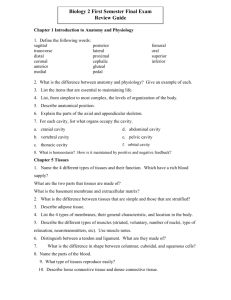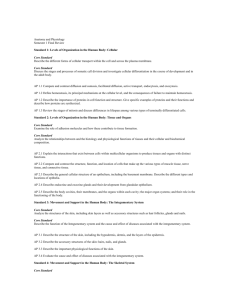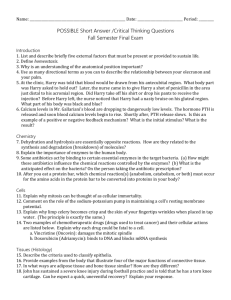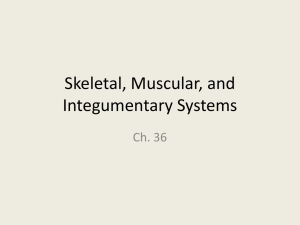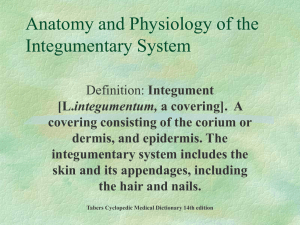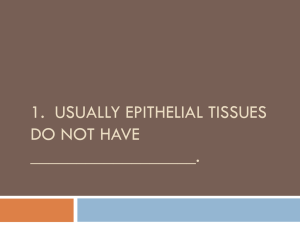Chapter 19
advertisement
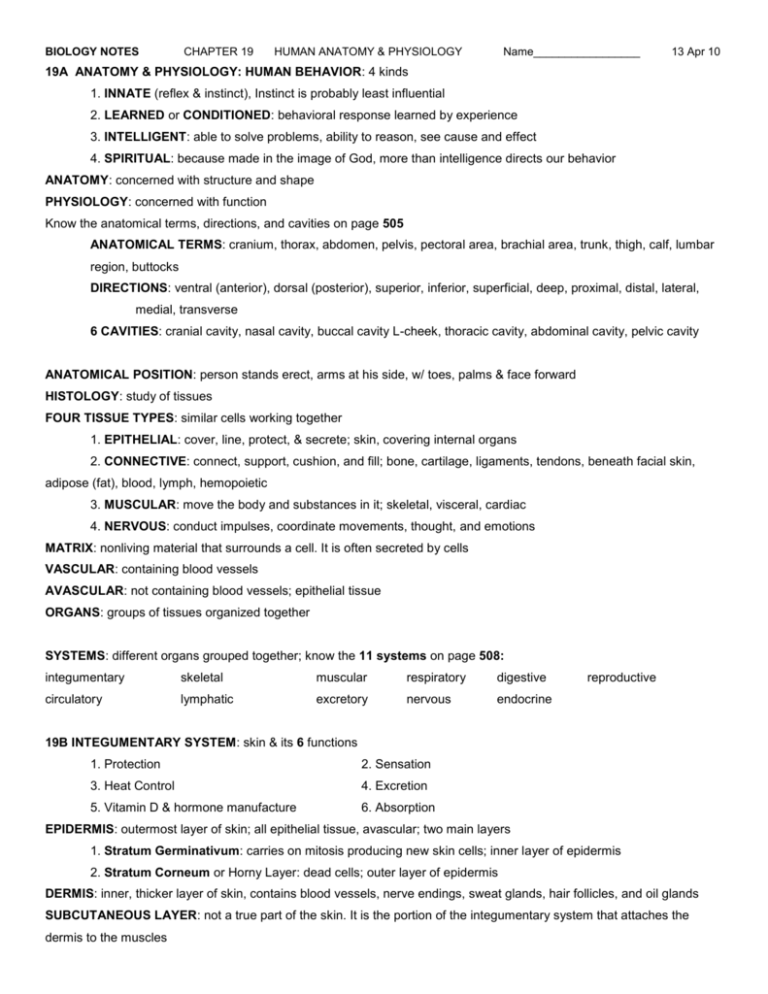
BIOLOGY NOTES CHAPTER 19 HUMAN ANATOMY & PHYSIOLOGY Name_________________ 13 Apr 10 19A ANATOMY & PHYSIOLOGY: HUMAN BEHAVIOR: 4 kinds 1. INNATE (reflex & instinct), Instinct is probably least influential 2. LEARNED or CONDITIONED: behavioral response learned by experience 3. INTELLIGENT: able to solve problems, ability to reason, see cause and effect 4. SPIRITUAL: because made in the image of God, more than intelligence directs our behavior ANATOMY: concerned with structure and shape PHYSIOLOGY: concerned with function Know the anatomical terms, directions, and cavities on page 505 ANATOMICAL TERMS: cranium, thorax, abdomen, pelvis, pectoral area, brachial area, trunk, thigh, calf, lumbar region, buttocks DIRECTIONS: ventral (anterior), dorsal (posterior), superior, inferior, superficial, deep, proximal, distal, lateral, medial, transverse 6 CAVITIES: cranial cavity, nasal cavity, buccal cavity L-cheek, thoracic cavity, abdominal cavity, pelvic cavity ANATOMICAL POSITION: person stands erect, arms at his side, w/ toes, palms & face forward HISTOLOGY: study of tissues FOUR TISSUE TYPES: similar cells working together 1. EPITHELIAL: cover, line, protect, & secrete; skin, covering internal organs 2. CONNECTIVE: connect, support, cushion, and fill; bone, cartilage, ligaments, tendons, beneath facial skin, adipose (fat), blood, lymph, hemopoietic 3. MUSCULAR: move the body and substances in it; skeletal, visceral, cardiac 4. NERVOUS: conduct impulses, coordinate movements, thought, and emotions MATRIX: nonliving material that surrounds a cell. It is often secreted by cells VASCULAR: containing blood vessels AVASCULAR: not containing blood vessels; epithelial tissue ORGANS: groups of tissues organized together SYSTEMS: different organs grouped together; know the 11 systems on page 508: integumentary skeletal muscular respiratory digestive circulatory lymphatic excretory nervous endocrine reproductive 19B INTEGUMENTARY SYSTEM: skin & its 6 functions 1. Protection 2. Sensation 3. Heat Control 4. Excretion 5. Vitamin D & hormone manufacture 6. Absorption EPIDERMIS: outermost layer of skin; all epithelial tissue, avascular; two main layers 1. Stratum Germinativum: carries on mitosis producing new skin cells; inner layer of epidermis 2. Stratum Corneum or Horny Layer: dead cells; outer layer of epidermis DERMIS: inner, thicker layer of skin, contains blood vessels, nerve endings, sweat glands, hair follicles, and oil glands SUBCUTANEOUS LAYER: not a true part of the skin. It is the portion of the integumentary system that attaches the dermis to the muscles HAIR: root of a hair lies in a hair follicle. Goosebumps or gooseflesh is caused by the contraction of little erector muscles SEBACEOUS GLAND: oil gland that keeps the hair and skin soft SWEAT GLANDS: 80 per square inch; produce perspiration (99% water & 1% salts) to cool body MELANOCYTES: cells that produce melanin the pigment that give skin its color FIRST-DEGREE BURN: damage to outer epidermal layers only. (mild sunburns) SECOND-DEGREE BURN: all epidermis & some dermis damaged. (severe sunburns) THIRD-DEGREE BURN: all epidermis, dermis, & some subcutaneous damaged 19C THE SKELETAL SYSTEM: framework for body support, protection of delicate organs, and production of blood cells Know the parts of a long bone page 513: epiphysis endosteum periosteum red bone marrow shaft marrow cavity spongy bone compact bone, yellow bone marrow epiphyseal plate OSTEOCYTES: bone cells that secrete the bone matrix. They are nourished through bone cells through canaliculi OSSIFICATION: converting of cartilage into bone; calcium is major mineral in bone Know the names of the bones- page 518; skull, maxilla, mandible, clavicle, ribs (7 pairs true, 3 pairs false, 2 pairs floating) sternum, scapula, humerus, sacrum, radius, ulna, ilium, pubis, ischium, carpals, metacarpals, phalanges, (fəˈlanjēz; or fāˈlanjēz) femur, patella, tibia, fibula, tarsals, metatarsals, calcaneus (kalˈkānēəs) VERTEBRA: 4 PARTS: page 517: transverse processes neural arch spinous process (ˈspīnəs) body JOINT: connection called a ligament between 2 or more bones or between cartilage and bone 4 joint types: 1. Ball-and-socket: shoulder and hip 2. Hinge: elbow, knee, between phalanges 3. Pivot: between atlas and axis (top two bones of neck on which the skull rests) 4. Gliding: between carpals and tarsals TENDONS: fibrous connections between muscles and bones SYNOVIAL MEMBRANE: lines inner surface of joints. It secretes synovial fluid that lubricate and acts as a shock absorber for the joint 19D THE MUSCULAR SYSTEM THE 3 TYPES OF MUSCLE TISSUE: 1. SKELETAL MUSCLE: striated; under voluntary control; usually attached to bones 2. SMOOTH (visceral) MUSCLE: nonstriated; not under conscious control; in inner organs 3. CARDIAC MUSCLE: striated and branched; only in the heart MYOFIBRILS: threadlike structures in the cytoplasm of each muscle fiber cell that run the whole length of the fiber Energy for muscle fiber contraction comes from ATP produced in the mitochondria STRUCTURAL PROTEIN FILAMENTS: actin & myosin PRIME MOVER: muscle that performs the action ANTAGONIST: muscle that is relaxed and stretched during movement ANTAGONISTIC PAIRS: muscles that have opposite movements; ex- biceps brachii and triceps brachii Know the 8 muscle actions on page 525: flexor extensor abductor adductor rotator levator depressor sphincter

